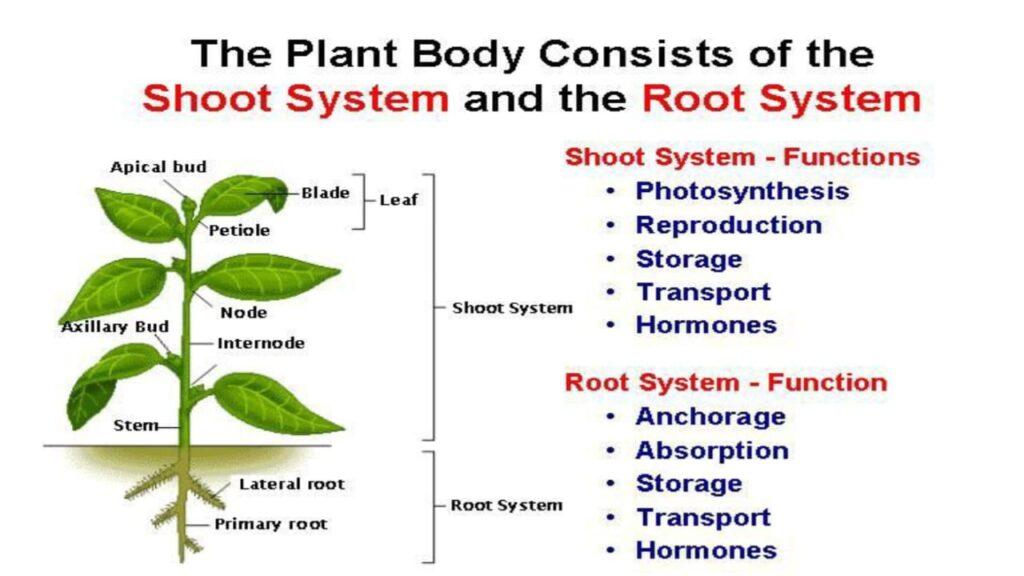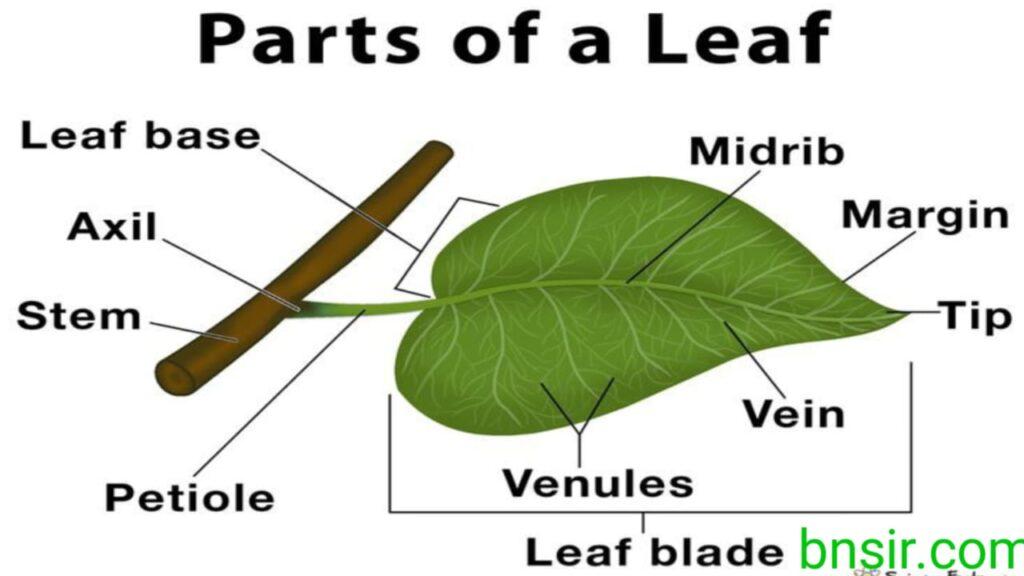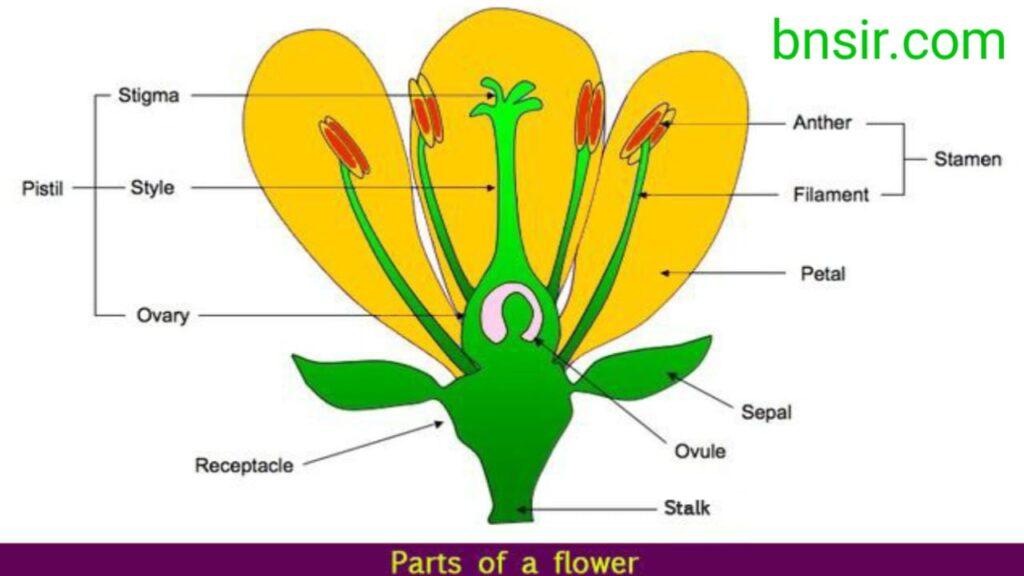Flowering Plants: From the tiny grass to the tall neem, from the prickly cactus to the floating lotus. from the bushy China rose to the climbing gourd, plants are of many types. In this chapter, we will discuss only those plants which bear flowers, or flowering plants. There are many plants. like ferns, mosses, pines and firs, which do not have flowers, but you will learn about them later.
TYPES OF PLANTS
There are many ways of classifying flowering plants. On the basis of size and kind of stem, they can be classified into herbs, shrubs and trees.
Herbs
These are small plants with soft. green stems, which may or may not have branches. Most herbs live for just one season or two seasons. They are known as annuals and biennials respectively. Rice, mustard and sunflower are annuals, while radish, beet and carrot are biennials. Some herbs, like canna, do live for many years, however. These are called perennials. Some herbs have a weak stem which cannot stand erect. Such plants, called creepers and climbers, grow along the ground or climb with the help of a support. Many garden plants, like marigold, petunia, aster and sweet pea, are herbs. So are crop plants like potato, tomato, spinach and wheat.
Shrubs
Shrubs are medium-sized plants which can grow up to 8 or 9 feet. They look bushy because they have many branches, which start from the base of the stem and grow in every direction. The stem is hard and woody, unlike the stem of herbs. These plants are often grown as hedge plants. China rose, crepe jasmine (chandni), henna (mehandi) and rose are some shrubs.
Trees
Trees are tall, perennial plants with a thick, hard, woody stem called trunk. Branches arise from the trunk after a certain height. Mango, kikar, guava, neem and eucalyptus are some trees. Stand under them and look up. You will find that the branches arise from nearly the top of the stem. Trees like coconut and date palm do not have branches.
PARTS OF THE FLOWERING PLANTS
A plant has two parts. The part above the ground, consisting of the stem, leaves, flowers and fruits, is called the shoot. The part below the ground is called the root.
The Root
The root The roots of land plants grow underground. Though they serve the same purpose, they are of two major types.

Grass and many cereal plants, like maize and wheat, have thin, fibrelike roots coming out of the base of the stem. These are called fibrous roots. In plants like spinach and mustard. on the other hand, there is a main root growing from the base of the stem. This main root, which grows vertically downwards, is called the tap root. It has branching roots coming out of it.
Functions of the root
- Did you find it difficult to pull out the plants in the previous activity? The root spreads out into the soil and holds a plant firmly to the ground, making it difficult to uproot it. Fixing the plant to the soil is a major function of the root.
- The root absorbs water and minerals from the soil. The plant uses these to manufacture food and carry out life functions. So, another major function of the root is to gather raw material for the plant.
- Roots serve still another purpose. By holding on to the soil, they bind it together and stop it from being blown away by the wind or washed away by the rain. This is why planting trees helps to protect the soil.
Some roots store food: The roots of some plants are modified, or look different from ordinary roots. These modifications occur to help the roots serve additional functions.A carrot, radish or turnip is a modified tap root. In these plants, the tap root gets swollen with stored food. The plant stores food in the root to use it when it needs to do so. Some fibrous roots also get modified to store food, for example, dahlia and sweet potato. We cat many food-storing roots.
Some roots provide extra support: Have you ever noticed ropelike growths hanging from the branches of a banyan tree? Some of these reach the sail and grow into it. These ropelike growths are called prop roots. To prop up something is to support it. Prop roots provide support to the spreading branches of a tree. The Indian Botanical Garden near Kolkata is famous for a huge banyan tree that has more than 900 prop roots.
When maize, sugar cane or screw pine (kewra) plants grow tall, the lower part of the stem produces roots called stilt roots. These roots support the plant and prevent it from tilting to one side. Plants like betel (paan) and money plant produce climbing roots, which hold firm to a support and help the plant climb.
The stem
Look at the stem of any plant. Notice the points from where the leaves grow. These are called the nodes. And the portion of the stem between any two nodes is called an internode. The smaller angle between the stalk of a leaf and the stem (at the nodej is called the axil. If you look carefully, you will notice buds at the axils. Branches grow out of these buds, which are called axillary buds. You may also notice buds at the tip of the stem or its branches. These are called apical buds (apical means at the apex). Branches and leaves grow out of these too. Buds that grow into flowers are called floral buds.

Functions of the stem
- The stem holds the plant upright and supports the branches. In big trees, the main stem or trunk. grows thick and strong. Such trunks have a hard, protective covering called bark.
- The stem bears branches, leaves, flowers and fruits. It spreads these organs out in all directions so that they function efficiently. For instance, it helps to spread out the branches and leaves so that the leaves get the maximum possible sunlight.
- Inside the stem, there are two sets of pipelines. One conducts water and minerals from the roots to the leaves. The other carries food from the leaves to the rest of the body of the plant. Thus, conduction or transport of materials is one of the functions of the stem.
Stems which store food: Just like roots, some stems are also modified to perform special functions. For example, potatoes and onions are stems modified to store food. So are turmeric (haldi) and Colocasia (arbi).
Stems that give support: The stems of climbers are modified into threadlike coiled growths called tendrils. These tendrils twine around any support close by and help the weak stem climb up. Plants of the gourd family and garden plants like the passion flower climb this way. Farmers and gardeners often provide support for such plants to climb up.
The Leaf
Some leaves (grass, bamboo) are narrow, some are oval (lemon), some circular (water lily and some oblong (banana). Some have a tapering tip (peepal), some have serrated (like a saw) edges (neem. China rose), and so on. In fact, you can recognise a plant by its leaves.
Parts of a leaf: The leaves of different plants may look different, but most leaves have a fe things in common. They have a flat, green leaf blade, or lamina. They also have a stalk, or petiole, and a point of attachment to the stem, called the leaf base. The petiole continues in the leaf as the midrib. Thin, linear structures, called veins, arise from the petiole and the midrib. These run across the leaf in various directions. They provide support to the leaf and transport water, minerals and food to and from the leaf.

Venation: When the veins run parallel to each other, as in grass, bamboo, banana canna, palms and sugar cane, the leaf is said to have parallel venation. And when the veins form a network across the leaf, as in peepal, China rose, mustard, cabbage, silk cotton, lemon, neem, litchi and mango, the leaf is said to have reticulate venation. Reticulum means a network. Generally, plants bearing broad leaves with reticulate venation have tap roots. And plants with narrow leaves showing parallel venation have fibrous roots. Thus, you can tell whether a plant has a tap root or fibrous roots by Just looking at its leaves.
Simple and compound leaves: The leaf blade of some leaves (like neem, gul mohar, tamarind and chhui mui) is divided into leaflets. Such leaves are known as compound leaves. A leaf is said to be simple, on the other hand, when it has a single leaf blade, like those of banyan. peepal, and so on. How will you know whether you are looking at a simple leaf or the leaflet of a compound leaf? Remember that a bud is present in the axil of a simple or compound leaf, but not the axil of a leaflet.
Functions of the leaf
The main function of a leaf is to prepare food from water and carbon dioxide. Water and carbon dioxide undergo a chemical change (reaction) to produce glucose. Chlorophyll, the green pigment present in leaves, helps this reaction by trapping sunlight, which provides the energy required for the reaction.
So, leaves normally have three functions.
- Manufacturing food
- Interchanging gases with the air
- Throwing out water vapour
Some leaves are modified to perform other functions. You have already learnt that in cacti, the leaves are modified into spines to prevent the loss of water. The scale leaves of ginger are modified to protect buds. There are still other modifications of leaves.
Some leaves provide support In some plants, like pea, masur (lentil) and glory lily, either the entire leaf or a part of the leaf is modified into a tendril. Like stem tendrils, leaf tendrils coil themselves around a support and help the plant climb.
Some leaves defend The spines of cacti do not only prevent the loss of water, but also discourage animals from eating the plant. Prickly pear (a cactus), date palm, dagger plant and prickly poppy are some plants whose leaves (or parts of leaves) are modified into spines for defence.
The flower
Some flowers. (rajnigandha) and like tuberose crepe Jasmine (chandni) are white, while others, like China rose and sunflower, are brightly coloured. Roses are fragrant. while oleanders (kaner) are not. The shapes, sizes and colours of flowers vary greatly, but they all have features in common.
Parts of a flower
The stalk of a flower is called the pedicel. The uppermost, swollen part of the pedicel is called the thalamus. The green, petal-like growths coming out of the thalamus are the sepals. The sepals enclose and protect the flower when it is a bud. Coloured or white petals grow inside the sepals in a circle.

The stalklike growths with swollen, powdery heads are the stamens. These are the male parts of the flower. The stalklike portion is called the filament, while the swollen tip Is the anther. The powdery substance which rubbed off on your fingers is pollen, which is contained in the anther.
The flasklike structure at the centre of the flower attached to the stalk with a swollen tip is called the carpel. One or more carpels form the female part of the flower, or the pistil. The swollen base which you cut open is the ovary, the stalk is the style, and the swollen tip is the stigma. When you cut open the ovary, you may have noticed tiny, egglike structures. These are the ovules, which later develop into seeds.
If you examined the flower carefully, you would have noticed that the sepals, petals and stamens grow out of the thalamus in circles. The outermost circle is formed by the sepals, then come the petals, then the stamens, and right at the centre is the pistil. Thus, the flower has four whorls. Any circular arrangement of leaves, petals, sepals, etc.. around a common axis is called a whorl.
However, all flowers do not have all four whorls. Sometimes the sepals and petals together form tepals, as in the tuberose. Some flowers have only stamens, while others have only carpels. Even when all four whorls are present, different flowers may have different structures. For example, the sepals may be free or joined. Similarly, the petals may be free or Joined. The petals may also be of different sizes, as in pea. The stamens and carpels may also be free or joined.
About Flowering Plants understand by YouTube Vedio

